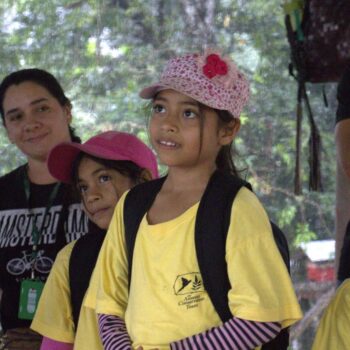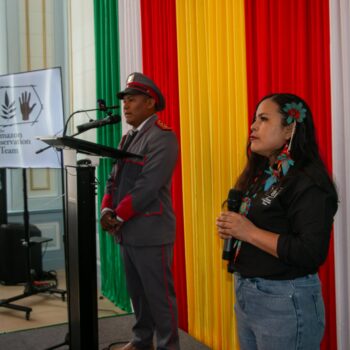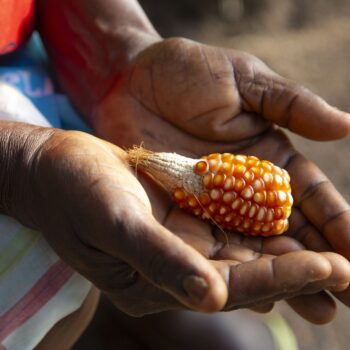Share this post
On the northwestern coast of South America live a most astonishing and spiritual tribe: the fabled Kogis of Colombia. These people dwell on the slopes of the Sierra Nevada of Santa Marta—the only snow-capped mountain overlooking the Caribbean Sea—along with three other associated indigenous groups. They choose to remain mostly in their villages and spend their days growing their crops, weaving their clothes and mochilas (fiber bags in which they carry the sacred coca leaves), and praying to the spirits.
This is why it surprised Liliana, ACT’s cofounder, when she received a request to host seven of the Kogi spiritual leaders at her home in Virginia in 2006. The Kogi had noticed an alarming phenomenon: the glaciers atop their sacred mountain were melting. They now wanted to ask what we outsiders, whom they refer to as “little brothers,” were doing to Mother Earth to cause this degradation. Of course, the changes they saw were some of the harbingers of climate change. In addition, the Kogis wanted to request help in protecting their 54 sacred pilgrimage sites along the sea. These areas are increasingly threatened by outsiders seeking to convert the land into everything ranging from industrial ports to plantations of illicit crops.
Liliana and her husband Mark opened their home to the Kogi (many of whom had never traveled) and Juan Mayr, Colombia’s former minister of the environment and one of the few outsiders to ever gain the Kogis’ full trust. Over the course of a week, the team hosted press conferences and dinners, helping the Kogi share their story and plea for the protection of their sacred lands—areas critical for Kogi livelihoods and traditions, as well as for their biological significance.
Sacred sites are one example of the intimate knowledge communities like the Kogi have of the natural world. Long before modern conservation, indigenous peoples understood that certain spots on Earth are especially important to the preservation of life. Over time, these areas were declared sacred by the spiritual leaders of the tribes, and their cultures evolved to safeguard them. These places frequently coincide with areas of exceptionally high biodiversity and are often located at the headwaters of rivers, in fragile ecological transition zones or in areas of vital habitat for endangered species.
Although initially hesitant to move beyond ACT’s geographic scope, Liliana and Mark agreed to partner with the Kogi to protect Jaba Tañiwashkaka–a 383-acre property along the coast and one of the most important sacred sites. The next step entailed a meeting with the Kogi on their lands in Colombia.
On the first night, the Kogi descended from their mountain homes to the coast to meet with their guests from ACT: Liliana Madrigal, Juan Mayr (a former ACT Board Member), and Bill Cameron (ACT Board Member). Liliana shared ACT’s goal and, in return, the Kogi detailed their creation stories. They described the ocean as Mother, the mountains as Father and the importance of harmony with the Earth. For them, the sacred sites were critical as a source of food, a place to make offerings, and the spot to gather the sea shells employed in their sacred ceremonies.
In December, 2012, the Kogi’s dream to protect Jaba Tañiwashkaka became a reality. In addition, the Colombian government designated the site as a National Cultural Monument, a new category of protection that can be declared for other sacred sites in the future.
On May 5, 2013, fifty Kogi mamos (shamans) and numerous Colombian government ministers and local leaders gathered together for a ceremony in which ownership and stewardship of the land was transferred to the Kogi. A plaque now adorns the site honoring its significance and those who made it possible.
While ACT is delighted with this success and the ensuing momentum to protect the 53 remaining sites, ample challenges remain. In 2014, ACT will work with the Kogis and our other partners to purchase two privately owned parcels of 70 and 15 acres adjacent to Jaba Tañiwashkaka. Sitting along the mouth of the Dibulla River, these areas have been used in Kogi ceremonies for thousands of years and are critical flamingo habitat; however, the pressure on the last remaining undeveloped coastal areas is enormous and these sites will be deforested or otherwise destroyed in the near future unless we act now. ACT invites you to join in this project to protect critical habitat for both the spiritual practices of our indigenous partners and vulnerable plant and animal species.
To receive never-before-seen photos of the Kogi and updates about our projects, join our mailing list now.




